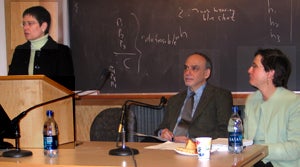The distinction between citizen and non-citizen lies at the heart of immigration law, and is often drawn at the border. But where precisely does the “border” lie in U.S. immigration law and practice?
That question was explored in a February 8 panel discussion at HLS by Professor Gerald Neuman ’86, Professor Ayelet Shachar of the University of Toronto faculty of law and HLS Clinical Professor Deborah Anker LL.M. ’84.
The definition of “border” is important, panelists said, because migrants attempting to cross into the U.S. at the territorial borders have traditionally had few rights, whereas those who are found by the government after they have already crossed have enjoyed fuller procedural protections. Now, however, the legal definition of the “border” is expanding to cover locations both well within and beyond the territorial boundaries, and the procedural rights of migrants are shrinking.
As a practical matter, Shachar said, the U.S. border is no longer defined in purely territorial terms, but is effectively determined by wherever there are points of contact between U.S. government officials and migrants seeking to enter the U.S. or stay here if they have already entered. Sometimes these contacts occur at the physical border itself, but increasingly they now occur abroad—in consular offices or foreign airports, for example—or well within the U.S., after migrants have been discovered inside the country.
Shachar reviewed the growing number of ways in which the government confronts migrants both within and outside the territorial boundaries of the United States, including the use of expedited proceedings by low-level immigration officials who have broad discretion to summarily make determinations excluding or deporting aliens who are trying to enter the country or to remain here after they have entered.
Neuman, calling these expedited reviews “atrocious,” cautioned against making the simplistic assumption that they are results of post-9/11 concern, noting that many of these expedited proceedings were legislated in 1996. And, he pointed out, the government and the courts found similar ways to clamp down on immigration rights during the Red Scare years of the McCarthy era. But he added that 9/11 has certainly contributed to what he termed “a new climate of fear today.”
Anker offered a review of recent Canadian legal developments relating to asylum seekers (mostly from Latin America) who enter Canada by way of the U.S., including a ruling last year by a Canadian court finding that the U.S. was not in compliance with a major international treaty on the rights of refugees. Students from HLS’s Immigration and Refugee Clinical Program worked on that case and their contribution was cited by the Canadian court.
The panel event was sponsored by the American Constitution Society, the Harvard Immigration Project, APALSA and SALSA.
